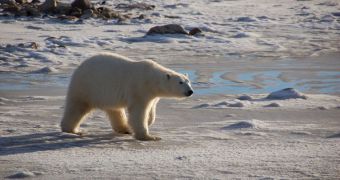About three years ago, the polar bear was officially introduced on the threatened species list, as authorities recognized the peril these animals were in. At this point, the entire species is heading for extinction, but this can still be avoided, experts say.
One of the main reasons why the mammals are endangered is because the amount of summer sea ice in the Arctic is dwindling, as a direct result of global warming and climate change.
The phenomenon is being produced by humans, who release vast amounts of greenhouse gases into the atmosphere every year. A large part of these gases is accounted for by the potent chemical carbon dioxide, which has been proven to promote global warming.
While the effects of climate change are still relatively harmless at or around the Equator, things are a lot bleaker at the poles, where sea-based ice sheets are melting at an alarming rate.
More concerning is that large amounts of multi-annual ice are melting. This ice cannot be easily replenished. When it's gone, seasonal ice takes its place, and this type of the stuff easily melts the following year.
As ice spreads dwindle, so too does the number of polar bears making a living on the shelves. These creatures are entirely dependent on the ices to survive, as is its may prey, the seal.
Over the past few years, as the Arctic experienced less and less ice growth, polar bear populations have been declining, heading straight for extinction. But a new study shows this can be avoided, if measures are taken without delay.
The only scientists can think of that would help boost populations is if GHG emissions are significantly reduced to much lower levels. This would ensure the recovery of Arctic ices within the coming decade.
In a paper published in this week's issue of the esteemed journal Nature, experts from the University of Washington, the National Science Foundation (NSF) and the US Geological Survey (USGS) say that emissions need to be reduced within the next decade or two.
“What we projected in 2007 was based solely on the business-as-usual greenhouse gas scenario. That was a pretty dire outlook, but it didn't consider the possibility of greenhouse gas mitigation,” says Steven Amstrup.
The expert is an emeritus researcher at the USGS and also holds an appointment as a senior scientist at the organization Polar Bears International, in Montana.
“Our current research provides strong evidence that it's not too late to save polar bears from extinction,” explains Eric DeWeaver, an atmospheric scientist at the NSF.
“We looked for Arctic sea ice tipping points in a climate model in which sea ice is known to be very sensitive to global warming, and we didn't find any,” he concludes.

 14 DAY TRIAL //
14 DAY TRIAL //